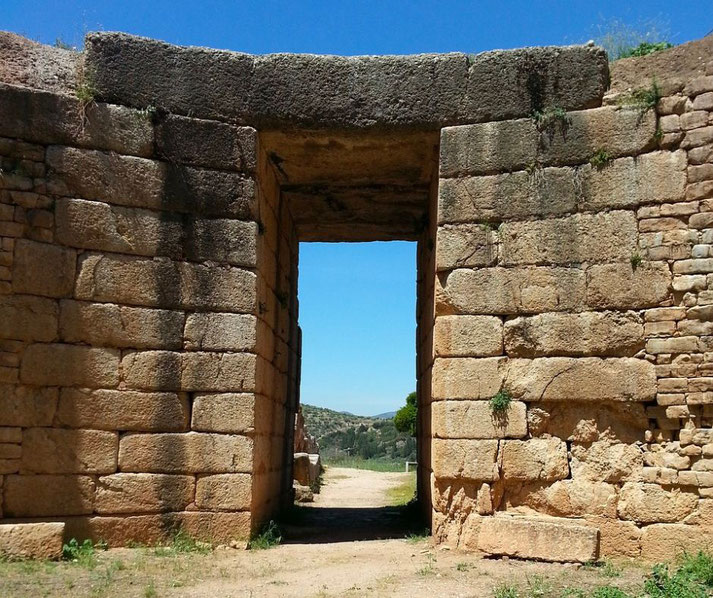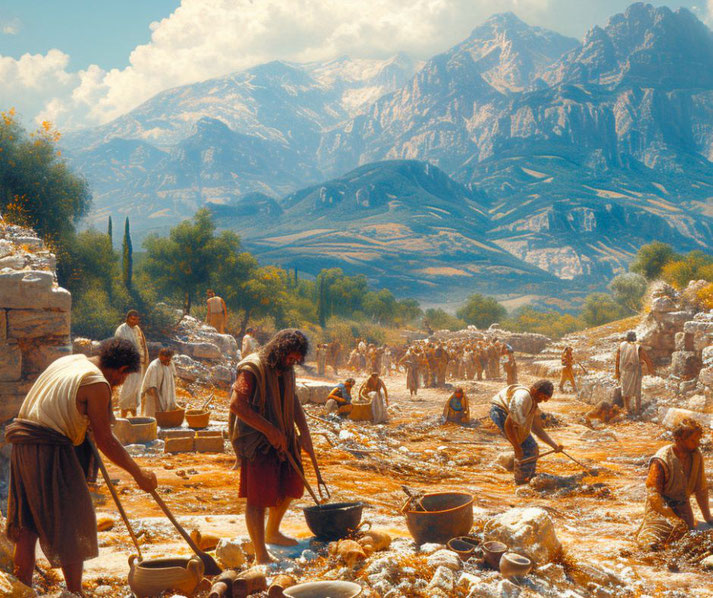The rise and fall of Mycenae: An ancient Greek superpower

Mycenae, an ancient city nestled in the northeastern part of the Peloponnese in Greece, played a pivotal role in Greek civilization and is often regarded as the cradle of the Mycenaean culture, which flourished from approximately 1600 to 1100 BCE.
The discovery of numerous artifacts, such as intricately crafted gold jewelry, detailed frescoes, and an array of pottery, paint a picture of a society rich in artistic expression and skilled craftsmanship, with a robust economy that engaged in extensive trade networks across the Mediterranean.
How Mycenae rose to power
The origins of Mycenae trace back to the Neolithic period, with evidence suggesting initial settlements as early as 7000 BCE.
However, it was during the early Bronze Age, around 3000 BCE, that the site began to gain prominence.
By the Middle Bronze Age, circa 2000 to 1600 BCE, Mycenae had evolved into a significant center of Greek civilization.
This period saw the construction of early fortifications, indicating the growing importance and wealth of the city.
The zenith of Mycenae's power and influence is often dated to the Late Bronze Age, particularly from 1600 to 1200 BCE.
It was during this time that the city became the dominant center of the Mycenaean civilization.
This era saw significant architectural and cultural developments, including the construction of the iconic palaces and the establishment of a complex social hierarchy.
The famed shaft graves, with their rich offerings and royal burials, date from this period, particularly from 1600 to 1500 BCE.
These graves revealed a wealth of gold, silver, and bronze artifacts, highlighting the affluence and artistic prowess of the Mycenaeans.
Mycenae's influence peaked around 1350 to 1200 BCE, a period that saw the expansion of its power across the Aegean and mainland Greece.
During this time, the city engaged in extensive trade networks, establishing connections with other prominent civilizations of the time, including the Minoans in Crete and the Hittites in Anatolia.
It is also during this period that the Linear B script, an early form of Greek writing, was used extensively for administrative purposes, signifying the complexity and sophistication of Mycenaean society.
The awe-inspiring architecture of Mycenae
The city's most iconic structure, the Lion Gate, constructed around 1250 BCE, serves as a monumental entrance to the citadel.
It is renowned for its colossal limestone relief of two lions, symbolizing the power and authority of the Mycenaean rulers.
This gate exemplifies the advanced engineering skills of the Mycenaeans, as it incorporates massive stones, some weighing several tons, meticulously fitted together without mortar.
Beyond the Lion Gate lies the grandeur of the Mycenaean palaces, with the most notable being the Palace of Mycenae, often associated with the legendary King Agamemnon.
These palaces were characterized by large central courtyards surrounded by various rooms for administrative and ceremonial purposes.
The intricate design and layout of these palaces reflect a high level of architectural planning and understanding of spatial organization.
Another significant architectural achievement of Mycenae is its tholos tombs, particularly the Treasury of Atreus, dated to around 1250 BCE.
This tomb is an exemplary feat of Mycenaean engineering, featuring a beehive-shaped structure with a corbelled dome.
The tomb's entranceway is marked by a large, lintel stone and a relieving triangle, demonstrating an understanding of weight distribution and structural stability.
The tholos tombs exhibit not only architectural prowess but also the importance of funerary practices and beliefs in the afterlife among the Mycenaeans.

The city's fortification walls, known as Cyclopean walls due to their massive size, are another hallmark of Mycenaean architecture.
Constructed in the 13th century BCE, these walls utilized enormous limestone boulders, roughly fitted together, creating an imposing barrier that provided both defense and a display of power.
The use of such massive stones in construction was so impressive that later Greeks believed they were built by the Cyclopes, mythical giants.
Who held power in the city of Mycenae?
The social structure was hierarchical, with a king or wanax at the apex, often thought to be like the legendary Agamemnon.
Below the king were the local rulers or basileis, who governed various regions of the Mycenaean realm.
These leaders were supported by a class of administrators and scribes, who were responsible for the complex bureaucracy that managed the city's resources and trade.
The Linear B tablets, discovered in the palace archives, provide evidence of this intricate administrative system, detailing records of transactions, inventory lists, and manpower.
The fertile plains of Argolis provided ample resources for agriculture, with the cultivation of grains, olives, and vineyards forming the backbone of the local economy.
Livestock farming, particularly of sheep and cattle, was another significant economic activity, providing wool, meat, and dairy products.
Mycenaeans traded with other Greek city-states, as well as with distant lands like Egypt, the Levant, and the Anatolian coast.
They exported goods such as oil, wine, and crafted products, including pottery and metalwork, in exchange for luxury items like ivory, precious metals, and exotic spices.
Slavery was also a part of Mycenaean society, with enslaved individuals performing various labor tasks.
The Linear B records mention groups of people referred to as do-e-ro, who were likely captive or enslaved workers, playing a vital role in the Mycenaean economy, particularly in agriculture and construction.
What archaeologists found at Mycenae
The first significant excavations at Mycenae began in the 19th century, spearheaded by Heinrich Schliemann, a pioneering figure in the field of archaeology.
Schliemann, famous for his work at Troy, turned his attention to Mycenae in 1874.
His most notable discovery was the shaft graves in the Circle A area, where he found a treasure trove of artifacts, including the famous Mask of Agamemnon, gold jewelry, weapons, and funerary objects.
These findings provided invaluable insights into the funerary practices and craftsmanship of the Mycenaean civilization.
Following Schliemann's initial excavations, further archaeological work in the early 20th century continued to shed light on Mycenae's history.
Alan Wace, a British archaeologist, led excavations from the 1920s to the 1950s.
Wace's work focused on uncovering the palace complex, residential quarters, and grave circles.
His systematic approach and detailed recording of findings contributed significantly to the understanding of the Mycenaean architectural styles and urban layout.
More recent archaeological efforts have employed modern techniques such as ground-penetrating radar, digital mapping, and meticulous stratigraphic excavation.
These methods have allowed for more precise and detailed understanding of the site.
Contemporary excavations have focused not just on the palatial center but also on the surrounding areas, offering a broader view of Mycenaean urban planning and everyday life.

Why did Mycenae collapse?
The decline of Mycenae, a pivotal center of the Mycenaean civilization, was a gradual process that unfolded over several decades, culminating in the eventual fall of the city around 1100 BCE.
This period of decline is part of a larger regional phenomenon known as the Late Bronze Age collapse, which affected several civilizations around the Mediterranean.
Around 1250 BCE, signs of strain began to appear in Mycenaean society.
There was a noticeable decrease in the construction of monumental architecture and a decline in artistic production, suggesting economic difficulties.
The Linear B records, which were abundant in the earlier periods, start to dwindle, indicating a breakdown in the administrative systems that had supported the Mycenaean palaces.
One of the critical factors contributing to Mycenae's decline was a series of invasions and internal conflicts.
Around 1200 BCE, the city, along with other Mycenaean centers, faced invasions from northern groups, possibly the Dorians, as suggested by later Greek tradition.
These invasions, coupled with internal rebellions, led to the destruction of many palatial centers and a breakdown of the centralized administrative structures that had governed Mycenaean society.
Natural disasters may have also played a role in Mycenae's downfall.
Archaeological evidence suggests that earthquakes and fires damaged several key sites during this period.
These natural events would have exacerbated existing social and economic problems, further destabilizing the region.
The Mycenaeans had been heavily dependent on trade with other civilizations, such as the Minoans in Crete and peoples in Anatolia and the Near East.
The collapse of these networks, possibly due to the instability in the region, would have had a significant impact on Mycenae's economy.
By the end of the 12th century BCE, the palatial system that had characterized Mycenaean civilization had collapsed.
The once-great city of Mycenae was reduced to a shadow of its former self, with a dramatic reduction in population and a return to simpler forms of economic and social organization.
This period marked the end of the Bronze Age and the beginning of a period of decline and obscurity in Greek history, often referred to as the Dark Age.
What do you need help with?
Download ready-to-use digital learning resources
Copyright © History Skills 2014-2025.
Contact via email
With the exception of links to external sites, some historical sources and extracts from specific publications, all content on this website is copyrighted by History Skills. This content may not be copied, republished or redistributed without written permission from the website creator. Please use the Contact page to obtain relevant permission.





